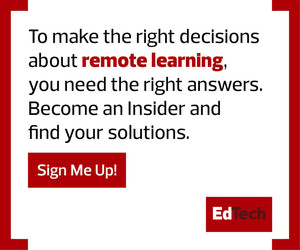What Is a Virtual Learning Environment?
According to Thompson, who is one of EdTech’s 30 Higher Ed IT Influencers to Follow this year, “the modern core of a VLE is the learning management system. If we think of that more broadly, it’s an interconnected web of technology resources and platforms in which virtual learning can take place.”
In other words, VLEs are learning management systems (LMSs) that have seen their reach extended with additional features or functions to help teachers and students connect. These VLEs still contain the core features of an LMS, such as online grade books and ways for students and teachers to authenticate for access, but they also offer extended benefits by allowing schools to connect additional functions, such as support for videoconferencing, online assignments or digital collaboration.
Thompson likens an LMS to a “potato-head toy” that allows schools to add on the features they want when they want them in order to create their preferred outcome.
READ MORE: Colleges centralize learning and operations.
Tips for Successful VLE Integration
It’s one thing to build or purchase a VLE; it’s another to effectively integrate it into current teaching practice. In part, this stems from potential technology disconnects: If legacy systems and solutions don’t play well with VLEs, schools could find themselves putting out IT fires instead of using these tools to their best effect.
Higher education institutions may also encounter challenges if staff lack the training and skills to make the best use of VLEs, or if they opt for more traditional teaching methods because they find them more familiar.
Here are five tips that can help streamline VLE integration.
1. Use What Works
As noted by Thompson, VLE environments can be open-source, homegrown or purchased from a provider. While the latter option is growing in popularity as universities look for streamlined solutions, the focus of a VLE is improved teaching, not enhanced technology.
In practice, this means finding what works and adopting new solutions as necessary, rather than as a matter of course.
2. Prioritize Organizational Leadership
Strong leadership is instrumental to effective integration. “Organizational or institutional leadership should be brought to bear,” says Thompson. “This helps ensure that digital teaching and learning is centered on effective practices.” In other words, strong leadership is necessary for VLE success.
3. Leverage Existing Resources
While VLE adoption has skyrocketed over the past two years, Thompson notes that “we have at least 25 years of research and professional practice and selecting best practices around these environments. We didn’t invent this two years ago.”
It’s worth making the best possible use of existing resources to avoid common errors and pitfalls. For example, the University of Central Florida has created a Teaching Online Pedagogical Repository, which offers strategies and insights into the pedagogical practice of online and blended teaching.
4. Invest in Preparation and Rollout
When it comes to VLEs, there is no silver bullet. While technology has come a long way, VLEs simply don’t offer the same intuitiveness as consumer mobile devices.
“The efficacy of VLEs varies incredibly based on what different teachers or instructors can do, or want to do,” says Thompson. “It’s important to consider the role of professional development centered on effective practices.”
5. Consider Your Infrastructure
“The missing piece in effective VLE adoption is almost always in the preparation and rollout, or the why and the how,” notes Thompson.
To help improve VLE integration, it’s worth considering both professional and technical infrastructure. From a professional standpoint, teachers need a why: Why are these tools better than current solutions, and what features do they offer to streamline educational practices?
From an infrastructure standpoint, schools need to think about how: Is technology delivered in-house, from the cloud, or through some combination of both? Is existing Wi-Fi bandwidth enough to support VLE functions? What security controls are in place to ensure authorized access and limit potential threats?
By considering why and how, schools can focus on where and when these solutions offer the biggest advantage.
EXPLORE: The technology behind America's top research universities.
Capturing Value from VLEs
When it comes to effective education, Thompson puts it simply: “At its most rudimentary, it’s four walls and a door. It’s a place for students and a place for teachers to communicate.”
VLEs exist to augment, rather than replace, current capabilities. Integration is critical to ensure that teachers are equipped to use new tools, administrators are prepared to support new initiatives and school technology infrastructure can keep pace with evolving VLE requirements.










